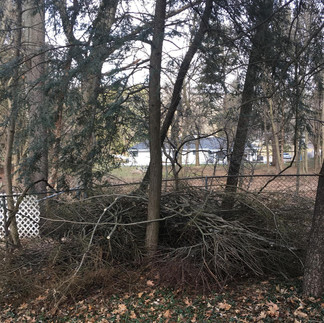Invasive Species Alert: Burning Bush
- zelienoplemusic
- Mar 11, 2022
- 2 min read
Burning Bush (Euonymus alatus) is an extremely popular landscape shrub that seems to be ubiquitous in suburban yards across most of the United States. People plant it because it grows super fast and the fall color is nice (but super fleeting and for most of the year it's quite ugly, IMO). Unfortunately, this Asian species is highly invasive. It's banned in many states, but in not enough of them so the conventional nursery trade continues to push this menace on customers. As mentioned in my previous blog post, I spend my winters doing ecological restoration for the Southwest Michigan Land Conservancy. Two days ago we were working in an oak savanna at the Chipman Preserve that was choked with invasive species. The main culprits were Oriental Bittersweet, Autumn Olive, Honeysuckle and Burning Bush. None of these species were intentionally planted in this beautiful but rare ecosystem. The seeds were carried to this spot by way of bird poop from when they feasted on the berries from domestic landscapes. What you plant in your yard matters! As a result, the native flora was suppressed by these garden escapees and the fauna suffers from a lack of quality native habitat (food, shelter and breeding grounds). This is a big problem but can be solved by not planting exotic species in your yard and if they're already there please remove them.
That is exactly what I did yesterday. My client moved into her new home a few months ago and hired me for an ambitious project to restore her yard to be a functional habitat for birds. The first, and probably the most important step, was to remove the invasive species that have been there from around the 1970's. And there was a lot of that stuff there! I removed 13 Burning Bushes, a large colony of Asian Honeysuckle, a few Asian Cherry trees, a couple White Mulberry and quite a few Japanese Barberry shrubs. When the weather warms I will return to tackle the Vinca Minor (aka "Periwinkle") that is carpeting a section of her yard that has wonderful native Hemlocks and White Pines. I haven't even planted one native plant yet but the yard is already in a much improved state as it was a couple of days ago. With the cuttings we created a brush pile in the corner of the back of her yard that will serve as shelter for overwintering birds and many other valuable fauna.
As a replacement for these shrubs I have a few native options in mind like Shrubby St. John's Wort, Red Osier Dogwood, Dwarf Chinquapin Oak, and Shrubby Cinquefoil. All amazing-looking native shrubs that are highly functional for pollinators and birds.















Comments